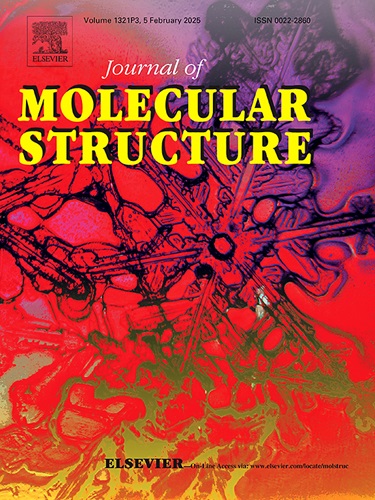Terephthalaldehyde and isophthalaldehyde-derived Schiff bases: A study of structural, computational, and biological aspects
IF 4.7
2区 化学
Q2 CHEMISTRY, PHYSICAL
引用次数: 0
Abstract
Three new Schiff base derivatives using simple and economical aldehydes like terephthalaldehyde (TPA) and isophthalaldehyde (IPA), with different amine precursors, were successfully synthesized under moderate circumstances. These compound are designated as follows: (1E,1′E)-1,1′-(1,4-phenylene) bis (N-(5-methylthiazol-2 yl)methanimine)(4-PMTM)(L1), (1E,1′E)-1,1′-(1,3-phenylene) bis(N-(5-methylthiazol-2-yl) methanimine) (3-PMTM) (L2), and (1E,1′E)-N, N''-((1E,1′E)-1,3-phenylenebis(methaneylylidene)) bis(N'-(2-hydroxynaphthalen-1-yl)formimidamide)(PMHF)(L3). The synthesized compounds were characterized using IR, 1H NMR, 13C NMR, elemental analysis, and thermogravimetric analysis (TGA). Their solubility was evaluated across various solvents. A single-crystal X-ray diffraction (SCXRD) study of L1 was conducted using MoKα radiation (λ = 0.7107 Å). Computational analyses, including DFT and molecular electrostatic potential (MEP) studies, were employed to optimize structures and assess electronic properties. Molecular docking revealed notable antibacterial potential, further supported by in silico ADME profiling, indicating drug-like behavior. In vitro antibacterial assays against MRSA, B. subtilis, and Escherichia coli identified L3 as the only active Schiff base.

对苯二甲酸和苯二醛衍生的希夫碱:结构、计算和生物学方面的研究
以简单经济的对苯二醛(TPA)和对苯二醛(IPA)为原料,以不同的胺为前体,在中等条件下合成了三种新的希夫碱衍生物。这些化合物被命名为:(1E, 1E)-1,1 '-(1,4-苯基)双(N-(5-甲基噻唑-2基)甲亚胺)(4-PMTM)(L1), (1E, 1E)-1,1 '-(1,3-苯基)双(N-(5-甲基噻唑-2-基)甲亚胺)(3-PMTM) (L2)和(1E, 1E)-N, N'-((1E, 1E)) -1,3-苯基-双(甲酰基)甲亚胺)(N'-(2-羟基萘-1-基)甲米酰胺)(PMHF)(L3)。通过IR、1H NMR、13C NMR、元素分析和热重分析(TGA)对合成的化合物进行了表征。它们在不同溶剂中的溶解度被评估。利用MoKα辐射(λ = 0.7107 Å)对L1进行了单晶x射线衍射(SCXRD)研究。计算分析,包括DFT和分子静电势(MEP)研究,用于优化结构和评估电子性能。分子对接显示出显著的抗菌潜力,进一步支持在硅ADME分析,表明药物样行为。对MRSA,枯草芽孢杆菌和大肠杆菌的体外抗菌试验鉴定L3是唯一有效的希夫碱。
本文章由计算机程序翻译,如有差异,请以英文原文为准。
求助全文
约1分钟内获得全文
求助全文
来源期刊

Journal of Molecular Structure
化学-物理化学
CiteScore
7.10
自引率
15.80%
发文量
2384
审稿时长
45 days
期刊介绍:
The Journal of Molecular Structure is dedicated to the publication of full-length articles and review papers, providing important new structural information on all types of chemical species including:
• Stable and unstable molecules in all types of environments (vapour, molecular beam, liquid, solution, liquid crystal, solid state, matrix-isolated, surface-absorbed etc.)
• Chemical intermediates
• Molecules in excited states
• Biological molecules
• Polymers.
The methods used may include any combination of spectroscopic and non-spectroscopic techniques, for example:
• Infrared spectroscopy (mid, far, near)
• Raman spectroscopy and non-linear Raman methods (CARS, etc.)
• Electronic absorption spectroscopy
• Optical rotatory dispersion and circular dichroism
• Fluorescence and phosphorescence techniques
• Electron spectroscopies (PES, XPS), EXAFS, etc.
• Microwave spectroscopy
• Electron diffraction
• NMR and ESR spectroscopies
• Mössbauer spectroscopy
• X-ray crystallography
• Charge Density Analyses
• Computational Studies (supplementing experimental methods)
We encourage publications combining theoretical and experimental approaches. The structural insights gained by the studies should be correlated with the properties, activity and/ or reactivity of the molecule under investigation and the relevance of this molecule and its implications should be discussed.
 求助内容:
求助内容: 应助结果提醒方式:
应助结果提醒方式:


